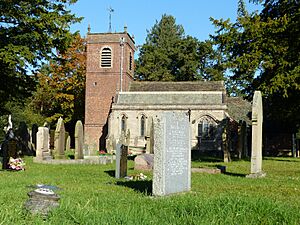St Peter's Church, Swettenham facts for kids
Quick facts for kids St Peter's Church, Swettenham |
|
|---|---|

St Peter's Church, Swettenham, from the south
|
|
| Lua error in Module:Location_map at line 420: attempt to index field 'wikibase' (a nil value). | |
| OS grid reference | SJ 801 672 |
| Location | Swettenham, Cheshire |
| Country | England |
| Denomination | Anglican |
| Website | Swettenham, St Peter |
| History | |
| Status | Parish church |
| Architecture | |
| Functional status | Active |
| Heritage designation | Grade II* |
| Designated | 14 February 1967 |
| Architect(s) | J. M. Derrick (1846 restoration) |
| Architectural type | Church |
| Style | Romanesque Revival Gothic Revival |
| Completed | 1926 |
| Specifications | |
| Materials | Brick and stone Slate roofs |
| Administration | |
| Parish | Swettenham |
| Deanery | Congleton |
| Archdeaconry | Macclesfield |
| Diocese | Chester |
| Province | York |
St Peter's Church is a historic church located in the small village of Swettenham, Cheshire, England. It is an active Anglican parish church, which means it's a local church for the community. The church is listed as a Grade II* building, showing its special historical importance. It is part of the diocese of Chester.
Contents
History of St Peter's Church
Experts believe that a church has stood on this spot for a very long time. It's thought that a Norman church was here first. Later, a church built with wooden beams stood on the site. Some of these old wooden beams can still be seen inside the church today.
Around the year 1500, the main part of the church, called the nave, was likely added. In the early 1720s, the building was covered in brick. During this time, and in later updates, much of the original wooden structure was removed.
The church has been updated several times over the years. In 1846, a major restoration (a process of repairing and improving an old building) was done by J. M. Derrick. This work was in the Romanesque style, which uses round arches. Another big update happened in 1865, this time in the Gothic Revival style, known for its pointed arches. The church had its most recent restoration in 1926.
Church Architecture and Design
Outside the Church
The church has a specific layout. It includes a tower on the west side. The main area, the nave, has four sections, with aisles (walkways) on both the north and south sides. There's also a chancel (the area around the altar) with two sections, and a porch on the north side.
The tower and the north aisle wall are built from brick. The south aisle wall is made of stone. All the roofs are covered with slate. On the west side of the tower, you'll see a door with a window above it. Higher up, there's a clock set in a diamond-shaped wooden frame.
At the very top of the tower, there's a brick parapet (a low wall) with a stone top. You can also see vase-shaped decorations called finials on the corners. A weather vane stands high on a metal support, showing the wind direction. Above the north porch, there's a unique sculpture of an ass's head wearing a crown. This is the symbol of the Mainwaring family, who were important in the area.
Inside the Church
Inside St Peter's Church, you'll find many interesting features. The pulpit (where the preacher stands) is believed to be from the time of Queen Anne (around 1722). The altar rails go around three sides of the altar. There are also three old chairs from the Jacobean period (early 1600s).
The church has two fonts (bowls for baptisms). One is from the 1700s, and the other is from the earlier Romanesque restoration. On the south side of the altar, there's a beautiful stained glass window. Some parts of this window contain glass from the Middle Ages, making it very old and special.
In the walls of the south aisle, there are four Gothic monuments, which are memorials to people. On the north aisle wall, you can see boards with the Ten Commandments painted on them. High up in the wall between the nave and the south aisle, there's a small piece of an Saxon cross.
In the vestry (a room used by the clergy), above a family memorial, an old fiddle is displayed. This fiddle was played in the church until about 1811. The church organ was built in 1964 by Noel Mander. It uses some pipes from an even older organ. The church also has a set of three bells. These bells are very old, dating from around 1500, 1627, and 1689. The church's old records, called parish registers, start from 1547. The accounts kept by the churchwardens (people who look after the church) begin in the 1600s.
See also
- Grade II* listed buildings in Cheshire East
- Listed buildings in Swettenham

